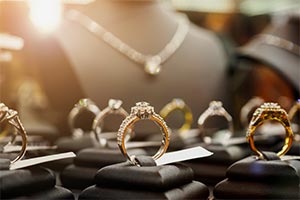Washing our hands for the 100th time today, but here's the thing...although our hands are now squeaky clean, how do we ensure our jewellery is bacteria free? What's more is that most of us are unaware of the damaging effects of cleaning products on our jewellery and diamonds?
Ben Stinson, an expert from the UK’s leading Hatton Garden jewellers, Diamonds Factory, has compiled a comprehensive guide to cleaning your jewellery in the times of COVID-19, with some additional information about the effects of anti-bacterial gel and washes on your jewellery.
1. Check if the jewellery is in good condition
Before you start cleaning, it is important to check the state of the jewellery to ensure there are no loose diamonds, or gems that may come off during the clean or everyday wear. You can do this by inspecting the claws of the piece or by using a safety pin to check how secure each stone is. If the stone is moving in the setting, we recommend taking it to a jeweller to have it professionally cleaned and re-set.
2. Begin cleaning using dishwashing liquid
Fill a small bowl with warm to hot water and add washing up liquid. Leave the jewellery to soak for 20 to 40 minutes, depending on how dirty the piece is. You can also try cleaning your diamond with vodka - yes you read that right. The distilled beverage can dissolve the dirt attached to the diamond thanks to the ethanol content.
3. Gently brush the diamond using a toothbrush
After leaving it to soak, use an unused soft-bristled toothbrush to give the stone a light brush. We recommend using a kids toothbrush because they are generally softer but remember to only keep this toothbrush for cleaning jewellery and no other purpose. Pro tip: remember to brush the base of the lower part of the diamond as a lot of dirt can build up at the base where the diamond is mounted.
4. Rinse the diamond under running water
Rinse the piece of jewellery under warm running water and repeat until you are happy with the appearance.
5. Safely dry the piece of jewellery
To dry off your jewellery, use a clean and fresh cotton or linen cloth as these materials will not scratch the metal as paper towels could. You can also let it air dry.
6. Polish the piece of jewellery
If you have a polishing cloth, you can rub it over your piece of jewellery to make the metal shine. Don’t forget to store your cloth in a re-sealable bag to avoid getting dust on it.
How often should I clean my diamonds and jewellery?
This process can be repeated once a week to help keep oils and products from building up. However, it is recommended that you take your diamond and jewellery to be professionally cleaned twice a year. To prevent the need to clean your items more frequently than once a week, we recommend removing your jewellery whenever washing your hands with soap, anti-bacterial hand gel, or washing up liquid.
How do anti-bacterial products affect my jewellery?
Anti-bacterial hand sanitiser and wash has become a staple accessory for most people around the world, however over time, excessive exposure can be damaging to anti-bacterial hand gel and can wear away the shine of your precious gems and metals. Although washing your hands is a necessity, a layer of hand wash and dirt can build up behind a stone, and the alcohol in the sanitiser can dry out the gems and lead to surface damage or cracking. Frequently using hand sanitiser also loosen prongs that hold diamonds in place, so we'd always recommend taking them off before using alcohol gel on your hands.


Add new comment